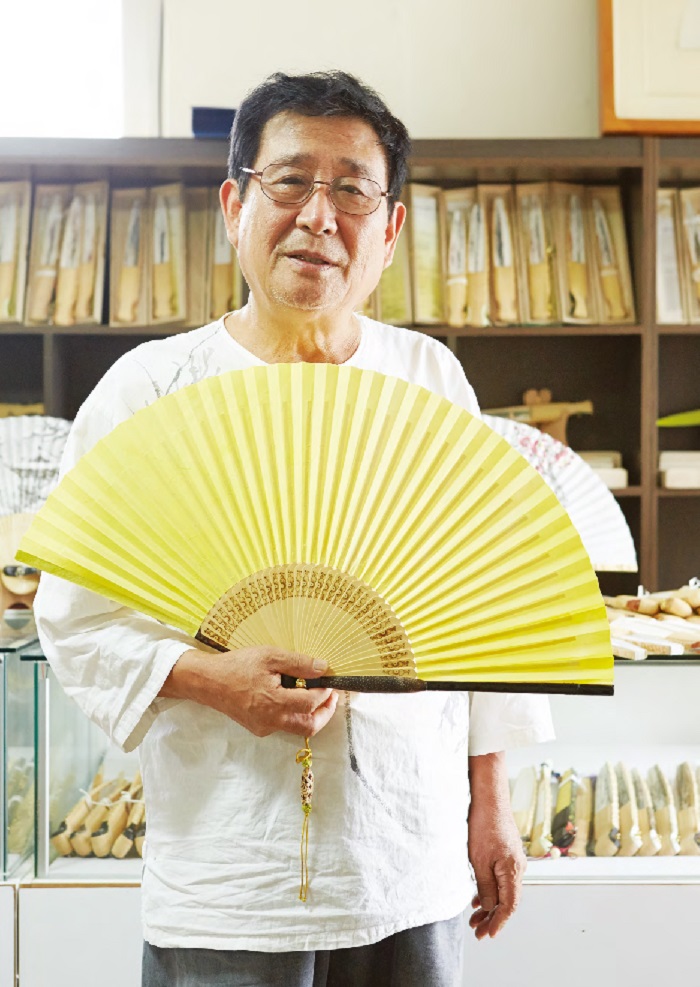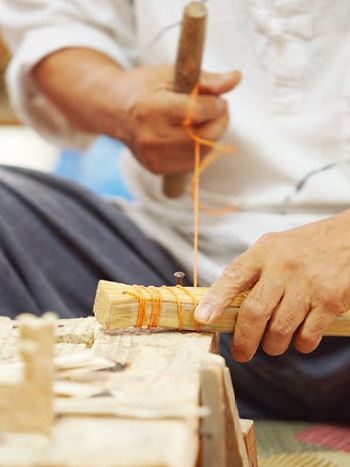View this article in another language
- 한국어
- English
- 日本語
- 中文
- العربية
- Español
- Français
- Deutsch
- Pусский
- Tiếng Việt
- Indonesian
Of the many souvenirs people acquire as tourists in Korea, a buchae, or traditional fan, is a very common one. Sold in nearly any shop in Insa-dong that boasts its selection of “traditional” gifts, the Korean buchae has perhaps become the country’s most prevalent traditional craftwork, available in a variety of colors and designs. It’s also one of the few traditional items that are still actively used today. While you’d be hard-pressed to find someone wearing hanbok on the subway during rush hour, or young musicians who are interested in learning traditional instruments like the gayageum, it is still a common sight to see buchae being used on summer days, even on the busy streets and transit routes of Seoul.

From Tool to Masterpiece
Park In-gweon, designated Jeollabukdo Intangible Cultural Heritage No. 10 and master buchae craftsperson, builds a type of fan that is not so easily accessible. Made entirely by hand and only using traditional methods and natural material, his buchae are a far cry from any you’ll find in a souvenir shop—and far more precious. Those who have seen the film “Gwansang” (2013) have witnessed Park’s work, embodied in the buchae used by actress Kim Hyesu. Viewers will get another chance to see his artistry in Lee Byeonghun’s upcoming film “Memories of the Sword.” Park has a whole list of production studios that have hired him in the past to make fans specifically for their film or soap opera.
“To be honest, I’m still not satisfied with what I’ve made so far,” Park says while handling some raw bamboo in his workshop, his hands calloused and nearly bleeding. His wife sits in the corner heating up some glue made from ground fish remains. Scattered all around him are pieces of bamboo, cut into various sizes and lengths; the walls are lined with tools for which this writer doesn’t even have the names. He picks up an incomplete fan—a bundle of split, carved and reassembled bamboo strands that have been tied together while the glue dries. “These fans, they involve so much detail, so much precision. It takes a lifetime to learn how to make them.”
Park grew up in a small town in Jeollanam-do and first learned the art of crafting buchae from his relatives. He didn’t decide to make a career of it, however, until his early 20s. Back then, before air-conditioners and electric fans were common, hand-held fans were the primary way for people to cool off, and were thus that much more important. “People don’t buy my fans for utilitarian reasons anymore,” Park says. “Now they purchase them as artwork, as something to display in their living room.” Indeed, Park’s creations are on par with any painting or sculpture money could buy. So much care and time goes into his pieces that it almost seems improper to actually use them for their practical purpose.
 Staying Native
Staying Native
Park specializes in a particular type of buchae called hapjukseon, a folding fan that dates all the way back to the Goryeo era. Each spoke on the fan is made by splitting individual bamboo strips, gluing them back together and arranging them into a neat, accordion-like structure. Hapjukseon fans are what you see people whipping out into a beautiful, multilayered semi-circle—something very much like a peacock’s tail feathers— and then carefully folding them back up afterwards. Park’s fans are so highly valued that people come directly to his home in Jeonju to buy them, for he doesn’t even have a shop.
“I have no time to run a business or operate a store. I work on my craft all day.” Craftsmen from China and Japan have approached him, requesting that he teach them the secrets of his art, but Park always refuses.
“If anyone can make the Korean hapjukseon, then its value drops,” Park explains. “This is a traditional craft that needs to stay in Korea, in the hands of those who know it best, here in Jeonju.” He explains that the art of hapjukseon is not something you can produce en masse or copy; it’s an ancient skill that requires lifelong dedication and a lot of patience. He recalls several people who first approached him as willing learners but, after realizing how much dedication and effort his craft requires, fled as quickly as they came.
“Apparently, not everybody wants to spend their entire lives making fans!” he laughs.
* Article from Korea Magazine (September 2014)

Master fan maker Park In-gweon
From Tool to Masterpiece
Park In-gweon, designated Jeollabukdo Intangible Cultural Heritage No. 10 and master buchae craftsperson, builds a type of fan that is not so easily accessible. Made entirely by hand and only using traditional methods and natural material, his buchae are a far cry from any you’ll find in a souvenir shop—and far more precious. Those who have seen the film “Gwansang” (2013) have witnessed Park’s work, embodied in the buchae used by actress Kim Hyesu. Viewers will get another chance to see his artistry in Lee Byeonghun’s upcoming film “Memories of the Sword.” Park has a whole list of production studios that have hired him in the past to make fans specifically for their film or soap opera.
“To be honest, I’m still not satisfied with what I’ve made so far,” Park says while handling some raw bamboo in his workshop, his hands calloused and nearly bleeding. His wife sits in the corner heating up some glue made from ground fish remains. Scattered all around him are pieces of bamboo, cut into various sizes and lengths; the walls are lined with tools for which this writer doesn’t even have the names. He picks up an incomplete fan—a bundle of split, carved and reassembled bamboo strands that have been tied together while the glue dries. “These fans, they involve so much detail, so much precision. It takes a lifetime to learn how to make them.”
Park grew up in a small town in Jeollanam-do and first learned the art of crafting buchae from his relatives. He didn’t decide to make a career of it, however, until his early 20s. Back then, before air-conditioners and electric fans were common, hand-held fans were the primary way for people to cool off, and were thus that much more important. “People don’t buy my fans for utilitarian reasons anymore,” Park says. “Now they purchase them as artwork, as something to display in their living room.” Indeed, Park’s creations are on par with any painting or sculpture money could buy. So much care and time goes into his pieces that it almost seems improper to actually use them for their practical purpose.

Park specializes in a particular type of buchae called hapjukseon, a folding fan that dates all the way back to the Goryeo era. Each spoke on the fan is made by splitting individual bamboo strips, gluing them back together and arranging them into a neat, accordion-like structure. Hapjukseon fans are what you see people whipping out into a beautiful, multilayered semi-circle—something very much like a peacock’s tail feathers— and then carefully folding them back up afterwards. Park’s fans are so highly valued that people come directly to his home in Jeonju to buy them, for he doesn’t even have a shop.
“I have no time to run a business or operate a store. I work on my craft all day.” Craftsmen from China and Japan have approached him, requesting that he teach them the secrets of his art, but Park always refuses.
“If anyone can make the Korean hapjukseon, then its value drops,” Park explains. “This is a traditional craft that needs to stay in Korea, in the hands of those who know it best, here in Jeonju.” He explains that the art of hapjukseon is not something you can produce en masse or copy; it’s an ancient skill that requires lifelong dedication and a lot of patience. He recalls several people who first approached him as willing learners but, after realizing how much dedication and effort his craft requires, fled as quickly as they came.
“Apparently, not everybody wants to spend their entire lives making fans!” he laughs.
* Article from Korea Magazine (September 2014)